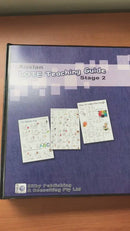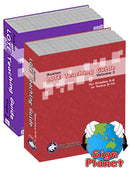Description
About the LOTE teaching guides
Our Auslan teaching guides cover K to 10. For full details go to our "About the Auslan Teaching Guides" page.
About LOTE Teaching Guide Volume 2
This extensive guide includes 443 pages and includes everything you need for 2 years teaching! It is written to be used in either grades 3-4 OR years 7-8, with a blended teaching model (especially for primary school children) that has some formal/instructional lessons intertwined with interactive content and game play.
You do not need to have done LOTE 1 with high school students and revision and catch up is embedded in material for high school students.
The goal within these teaching years is not just vocab building but also to explore linguistic concepts and really embark on information exchange and communication.
Every section includes a teachers reference dictionary and tips on teaching those signs, activities to use in class to reinforce the signs in a fun and engaging way. Every third section is a Bring-It-Together topic, that draws a naming topic with adjectives and verbs to extend communication, and introduce grammar and linguistics in a context.
Gradually over the years students move from naming everyday objects and people, to more complex communication
Used in over 200 schools already the popularity of this all inclusive guide is growing rapidly
Prerequisite: Requires no prior knowledge, however Lote 1 preferred. Some reading capability
Synopsis: Vocab building and introduction to linguistic concepts through a combination of game play and formal lessons
Topics covered in Year 1:
Broaden vocabulary & expand receptive and expressive skills
- Practice describing animals using 5-8 descriptors, inc. the use of the negative’ preposition.
- Use simple recipes in Auslan only as a path to food based communication.
- Practice describing family members in detail, including physical appearance, age and relationship to self.
- Explored formal vs informal communication for the first time, and looked at signing space and exaggeration
Total vocab inc: 321 + optional revision from lote 1
Specifically:
- Insects and Reptiles
- Numbers 1-10
- Bring-It-Together - Which Animal Do You Like?
- Emotions and Feelings (basic)
- Bring-It-Together - How Are You and About Me
- Basic Measurements and Big Numbers
- Bring-It-Together - Let's Cook Something Easy
- My Family
- Describing People
- Bring-It-Together - About My Family
Topics Covered in Year 2:
This year explores deeper concepts of Auslan linguistics & moves into speech presentations & interpreting.
- Expanded use of descriptive signs (receptive & expressive) & discusses animals (textures, sizes and appearances, habitats and food) and people (inc their appearance, occupations, and forms of transport).
- Expand and practice food preparation, including numbers and measurements.
- Enter the world of fingerspelling.
Total vocab inc: 734 + optional revision from lote 1
Specifically :
- Australian Animals
- Describing Animals (extended)
- Bring-It-Together - Which Animal Did That?
- Emotions and Feelings (Extended)
- Alphabet (Fingerspelling)
- Bring-It-Together - More About Me
- More Measurements, Fractions, Times & Dates
- Cooking Words
- Bring-It-Together - How Do You Cook That?
- Describing People (Extended)
- Occupations and Items at Work
- Bring-It-Together - What do you know about me?
Special Event Topics:
There is supplementary, optional topics on Birthdays, Easter and Christmas that can be implemented at the appropriate times in the year. The Birthday topic can be used as a short 5 min item as each child has a birthday; gradually expanded throughout the second year to include fingerspelling the students name. While the Easter and Christmas topics can be utilised as a fun end to term 1 & 4.
Aims and Objectives of Stage 2
Broadly speaking, the aim/objective of the stage 2 curriculum is to bring students from the mostly game play and vocabulary building curriculum of LOTE 1 into communication building and understanding Auslan. Through out this curriculum you will find that as vocabulary is introduced students will also be guided through an explanation of the language, grammar and linguistic basis for the language.
Specifically, students will :
- look at whole body signing, and how facial expressions and posture can influence the meaning of sign.
- Formal, Informal and Casual signing
- Why signs are what they are. Broadly speaking signs can be divided under meaning groups. That is to say groups based on how they get their meaning. An English equivalent would be Unicorn = Uni + Corn. Coming from the Latin words meaning one and horn. In the same way Auslan signs can be broken into base parts (like handshape, but also location, mimicry and so on) to understand their meaning.
- Exaggeration and Emphasis in Auslan
- Prepositions and suffix in Auslan
They will look at signs not in isolation, but begin to test their expressive and receptive skills in paragraphs; and in context of real life examples. They will move from noun-verb combination into conversations and communication in Auslan.
Content Samples
Sample of class handouts for Farm animals available on SignPlanet.net : here
There is also a video flick attached to this listing (see images, hover or tap to vatch in full screen) through that slowly page turns through the farm animal and colour chapters showing northern and southern editions of handouts, and a more abridged turn through other sections
What's in the folder
Presented in a Durable folder with plastic dividers and pockets packed full of resources.
- 444 Pages of teaching material!
- Every section includes teachers notes, a quick reference teachers dictionary
- Activities games and assessment activities to use in class
- CD-Rom with Menu for navigating all the printable handouts
Digital Content Option with SignPlanet.net

The Curriculum Material section on SignPlanet.net is divided according to each of the printed guides, with subsections for each chapter/learning area.
This includes teaching content for all three volumes and all CDROM content that comes with Volume 1 and 2!
Since publication of this guide
We have updated handouts and added additional material online available on SignPlanet.net with an Organisation license (purchased separately at discounts to LOTE Guide owners). The original folder included a DVD (Something To Sign About) that is no longer in production, and related songs are being uploaded to SignPlanet under the curriculum area.
We have added a number of online games that reinforce learning areas of the LOTE Teaching guides, and "watch and Learn" video play throughs.
For full details read the "About Auslan Teaching Guide Digital Content on SignPlanet.net" page
Purchase options
Volume 2 Folder only : $445
Volume 2 + 12 month Small organisation License to sign Planet : $ 595
RRP $300 for SP org lic + folder $445 = $745
Volume 2 + 3 + 12 month Small organisation License to sign Planet : $ 800
RRP $995
Your small site license provides for 4 consecutive users (seats). Upgrades available for more simultaneous seats










